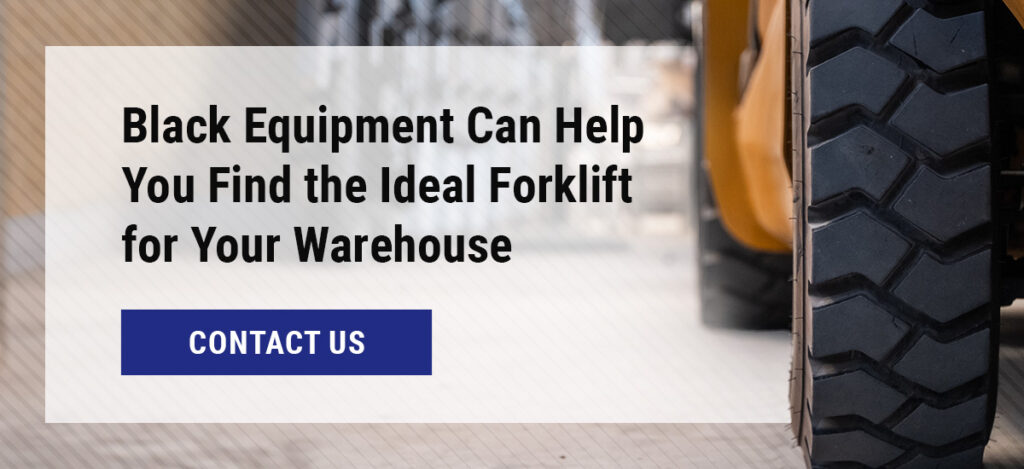Top Features to Look For in a Forklift for Your Warehouse

The right equipment is critical for maintaining high productivity and efficiency in warehousing. Your forklift must-have features and capabilities that meet your warehouse’s unique requirements, and a dependable business partner can help you ensure you find the most suitable equipment for your needs.
This guide will walk you through the top features of forklifts to consider when deciding which model to purchase.
Load Capacity
A forklift’s safe lifting capacity depends on where the load’s center of gravity is in relation to the lift’s body. Most forklifts list several capacities on their data plates to account for different load configurations.
The specific capacity fleet managers should look for when purchasing a forklift depends on various factors, including:
- Load composition: Uneven weight distribution can cause the load to exceed capacity even if it is within the range listed on the data plate. For example, loose materials can move within a container during transport and shift the load’s center of gravity.
- Lift height: The height at which a forklift holds a load directly impacts how much weight it can carry. For example, high mast forklifts often have a higher load capacity at lower lift heights than higher elevations.
- Tilt and reach: When a forklift tilts or extends a load, its center of gravity moves further from its original position. This change increases the required lifting capacity to maintain balance.
Load Positioning Capabilities
Easy, smooth positioning capabilities are essential for helping operators stay safe when lifting and carrying heavy loads. By shifting the load’s center of gravity, the operator can keep the load within the forklift’s stated capacity and avoid tip-overs and other accidents.
The right attachments can help increase functionality for forklifts without built-in positioning capabilities. For example, side shifters and fork positioners enable operators to adjust load positions from the cabin. This added capability enhances efficiency by eliminating the need for operators to dismount and take time to adjust the forks manually.
Operator Safety Features
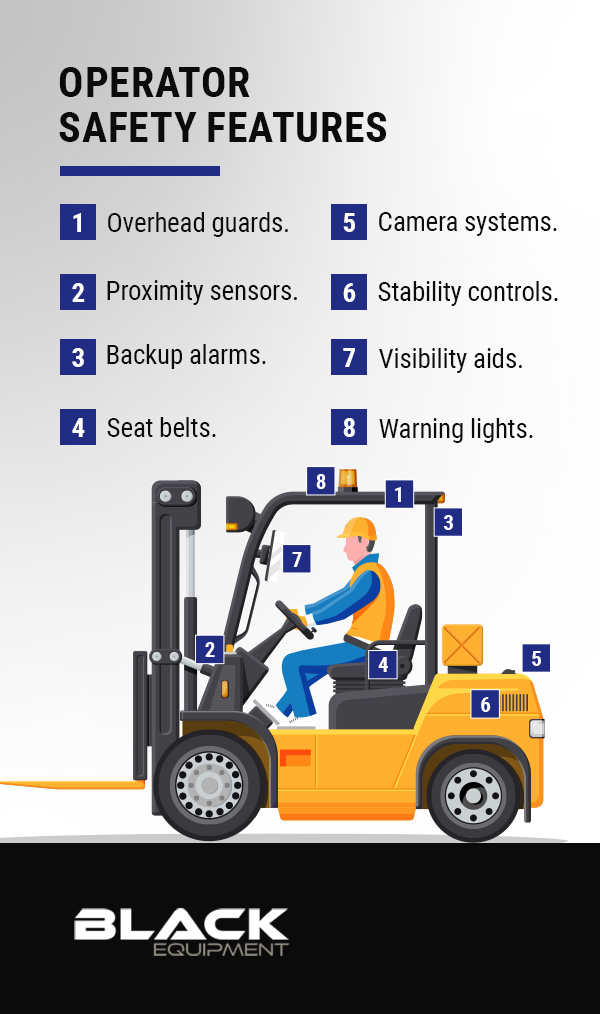
Like any other warehouse equipment, operating a forklift comes with a degree of risk. Fleet managers should consider purchasing lifts with advanced operator safety features, such as:
- Overhead guards.
- Proximity sensors.
- Backup alarms.
- Seat belts.
- Camera systems.
- Stability controls.
- Visibility aids.
- Warning lights.
These features provide proactive protections for operators and co-workers, reducing accidents and helping adhere to Occupational Safety and Health Administration (OSHA) regulations.
Active Operator Assist Systems
Industry-leading operator assist systems like Hyster Reaction and Yale Reliant are designed to improve workplace safety by reinforcing good driving habits, creating awareness of pedestrian traffic and avoiding other moving equipment and hard-to-see obstacles.
Some of the key features of active operator assist systems include:
- Environmental monitoring: These systems use a combination of cameras, ultrasonic sensors and light detection and ranging (LiDAR) to continuously monitor the forklift’s surroundings and alert operators to obstacles in their path. Object detection and proximity detection are environmental monitoring technologies that offer a more comprehensive solution. Real-time-location-sensing (RTLS) allows facilities to create “slow zones” and “no-go zones” (like pedestrian-only safe areas) that the lift trucks can aid operators in avoiding.
- Object detection: This system detects stationary obstacles and equipment and alerts operators to help them avoid collisions.
- Proximity detection: This technology helps operators maintain safe distances from similarly equipped co-workers or equipment operators and pedestrians wearing proximity badges, even when they move into the equipment’s blind spots.
- Real-time forklift adjustments: Automated systems activate a rapid response to environmental hazards in real time with changes like speed reductions, tilt and lift adjustments and application of traction controls while allowing operators to retain complete control.
- Dynamic stability assist: This system uses sensors to continuously monitor the forklift’s stability. It then activates corrective measures to protect the operator, such as slowing the lift down during sharp turns or warning operators about risky maneuvers.
- Operator behavior monitoring: This software tracks key parameters such as collisions, sudden braking, rapid accelerations and over-speeding to correct bad habits and hold operators accountable for unsafe driving.
Tire Type
The type of tire you need depends on the typical operating conditions in your warehouse. For example, forklifts that transport items from outdoor loading docks to areas within the warehouse may require pneumatic tires since they can operate on both smooth surfaces and rough terrain.
The three types of tires forklifts use include:
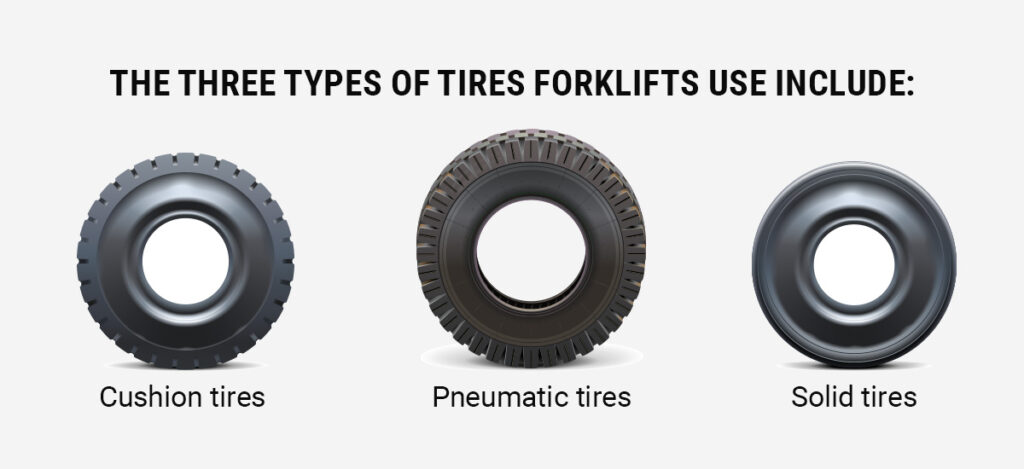
- Cushion tires: These tires are constructed of solid rubber and pressed directly onto the wheel, which causes the forklift to sit lower to the ground than the other tires. While this positioning provides a smaller turn radius for tighter turns, it also limits the forklift to indoor use on even surfaces.
- Pneumatic tires: Air-filled pneumatic tires are wider and longer than cushion tires, which gives them additional functionality in rough terrain. However, these tires can be punctured.
- Solid tires: Solid rubber tires are highly durable due to their inability to pop or puncture, which makes them useful for areas where sharp objects may be present. Due to their design, however, they are more costly than air-filled pneumatic tires. They are available in smooth and traction configurations.
Because forklifts are typically designed specifically for use with one type of tire, it is uncommon for operators to switch out one tire for another. An experienced salesperson can help you pick which tire is best for your operations and help you understand your forklift options.
Engine Type
Each type of motive power provides different capabilities. Therefore, it’s critical to choose one that optimizes operational efficiency.
Internal Combustion (IC)
Forklifts with an internal combustion engine (ICE) have been the industry standard for decades. They offer high levels of sustained power and easy refueling, which can keep operations on track even when the power grid goes down.
ICE forklifts typically use one of these fuel types, each with its own characteristics:
- Diesel
- Liquefied petroleum gas (LPG)
- Gasoline
- Compressed natural gas (CNG)
IC engines emit fumes that can be hazardous for employees and the surrounding environment. Forklifts with these engines should only be used outdoors or in well-ventilated spaces.
Electric
While electric forklifts tend to cost more upfront, they offer a higher lifetime value and emissions-free operation for indoor settings. The forklift’s capacity and charging requirements vary based on the type of battery the forklift uses:
- Lead-acid
- Thin plate pure lead (TPPL)
- Lithium-ion (Li-ion)
The main drawback of an electric engine is that it typically offers shorter runtime than an ICE forklift. While modern Li-ion-powered lift trucks can often run three shifts per day using only opportunity charging, other highly demanding work situations may benefit from ICE forklifts.
Operator Ergonomics
Ergonomic design is essential for helping employees avoid the development of musculoskeletal disorders (MSDs) and other work-related injuries. It also provides additional comfort, which can make it easier and more enjoyable for operators to complete their work safely and efficiently.
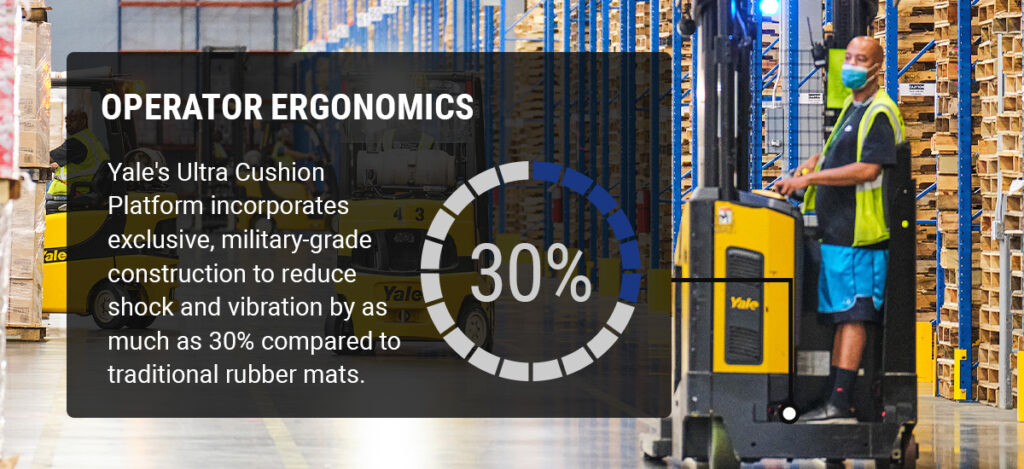
For example, Yale’s Ultra Cushion Platform incorporates exclusive, military-grade construction to reduce shock and vibration by as much as 30% compared to traditional rubber mats. This feature improves operator comfort and raises morale, which can help increase productivity and employee retention.
Some other examples of ergonomic features include:
- Adjustable seats: Operators can adjust their seats to ensure they have the proper lumbar support and feel comfortable throughout their shifts.
- Armrests: Armrests enable operators to rest their arms in a comfortable position, which can promote good posture.
- Intuitive controls: User-friendly controls positioned in an easy-to-reach location improve operator comfort and efficiency.
- Vibration reduction: Shock-absorbing platforms, suspension seats and similar features help reduce shocks and jolts that can cause lasting health issues, keeping employees safe and healthy.
- Enhanced visibility: Large windows and obstruction-free designs provide clear sightlines for safety and precision in stacking and retrieving loads.
- Noise-reducing cabins: Limiting exposure to loud noises is especially important for indoor applications like warehousing due to OSHA regulations and the need to provide a comfortable work environment.
Lift and Mast Height
A forklift must reach the appropriate height to enable workers to complete normal operations efficiently. Lift height directly impacts load capacity by shifting the load’s center of gravity, which can affect the operator’s ability to safely move the load to its destination.
Buyers must also consider a forklift’s minimum mast height, as some masts extend higher than others at the same lifting height.
An improperly specified mast height can:
- Interfere with the forklift’s ability to move through lower doorways.
- Cause issues when loading and unloading trucks.
- Affect overall forklift capacity.
- Limit accessibility of higher areas.
Buyers should discuss their requirements with an experienced salesperson who can guide them through the selection process.
Power Sources
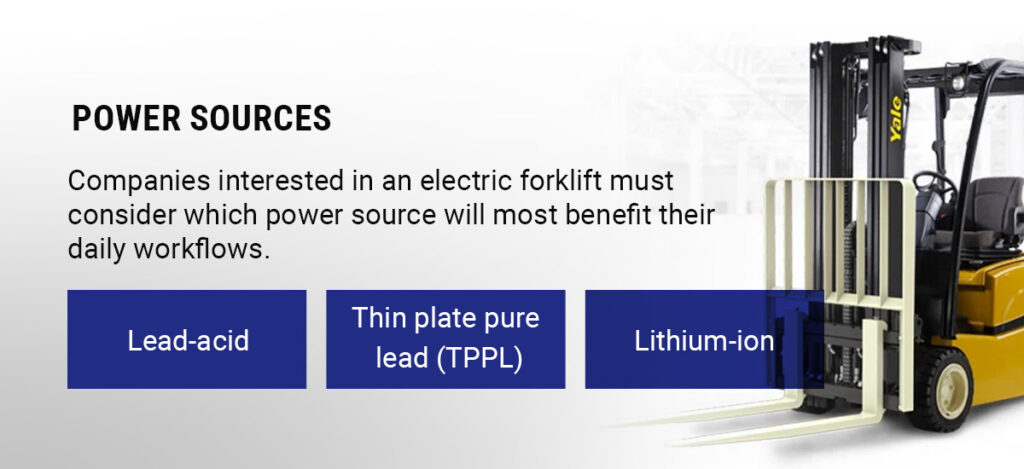
Companies interested in an electric forklift must consider which power source will most benefit their daily workflows. Operational demands help guide the choice of battery types:
- Lead-acid: While lead-acid batteries are cost-effective and trusted in high-demand industries, they tend to be less efficient than newer battery types due to slow charging times, the inefficiencies of swapping batteries and high maintenance requirements.
- Thin plate pure lead (TPPL): TPPL batteries offer improved performance, faster charging times and longer lifespans than lead-acid batteries, which makes them more suitable for multi-shift operations.
- Lithium-ion: Premium lithium-ion batteries offer reliable, long-lasting power due to their high cell quality and low maintenance requirements. Li-ion batteries also feature a modular design that allows for future scalability. They’re a good choice for multi-shift applications that can incorporate opportunity charging into their workflows.
For additional insight into the key differences between each motive power type, it’s best to contact a highly-trained equipment sales expert experienced with these operational demands.
9 Considerations for Choosing a Warehouse Forklift
These considerations help you visualize how the top features of forklifts play into your operations strategy.
1. Total Cost of Ownership
Buying new equipment costs more than what you pay upfront. You must also consider whether your business can afford the total cost of ownership (TCO), which includes all the costs associated with buying and owning a new forklift, such as:
- Purchase price
- Fuel and energy costs
- Depreciation
- Operator training costs
- Equipment insurance premiums
- Maintenance and repairs
- Potential downtime losses
- Resale value
The specific TCO varies based on the company’s chosen forklift model. A sales expert with experience in similar situations can help managers understand how a forklift fits into their operating budget and provide alternative recommendations if the specified model exceeds what the company can afford.
2. Operator Training Requirements
Since operator training is time-consuming, fleet managers should consider purchasing forklifts with straightforward controls and easily accessible training resources. These resources help lower the learning curve, saving the business valuable time and money in training and upskilling operators.
To remain safe and legal, operators require the proper licensing for the forklift type they intend to operate. The most common warehouse licenses available to operators in the U.S. include:
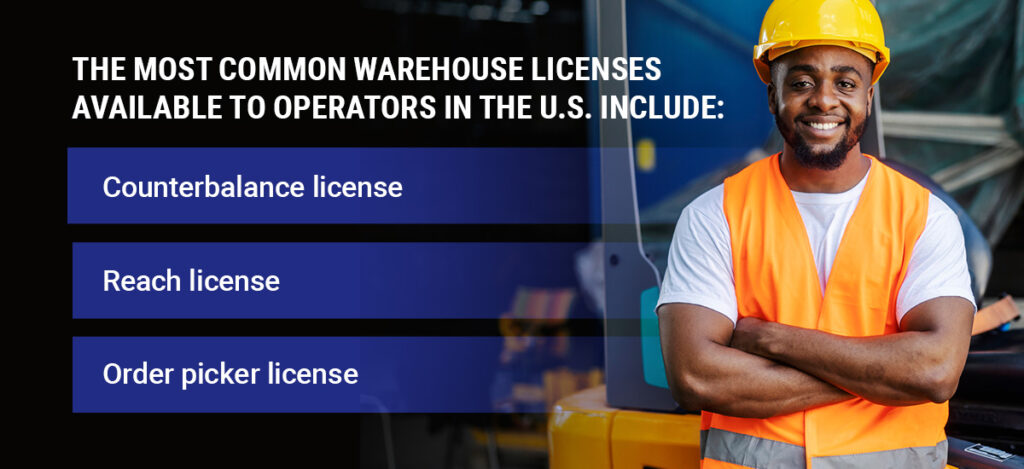
- Counterbalance license: Most operators require a counterbalance forklift license, as it’s the most common type.
- Reach license: Reach forklifts require specialized skills because they’re specifically used in tight, narrow spaces, often while manipulating loads at great heights.
- Order picker license: Order pickers require operators to safely move products onto an elevated loading platform while at various shelf heights.
Black Equipment, for example, provides forklift operator training courses to help companies ensure employees have the skills needed to use their new equipment. They also offer Train the Trainer certifications so companies can continue the training process in-house.
3. Fleet Management and Scalability
Emerging technologies like telematics and software integration help fleet managers monitor performance and usage to optimize operations. As demand grows, it’s vital to ensure the forklift you choose fits into your business’s future operational expansion and fleet upgrade plans.
It’s also important to consider each forklift’s possible need for additional power capacity as operations expand. Lithium-ion batteries, for example, have a modular design that enables you to add capacity to your equipment whenever you need to accommodate higher demand.
4. Application-Specific Attachments
Companies with unique material handling applications benefit from attachments like specialized forks, clamps and rotators. These attachments offer additional functionality to enhance work efficiency and reduce product damage.
For more assistance in finding the right attachment, companies should work with their equipment dealers to discuss their requirements in detail.
5. Environmental Impact
Any piece of equipment that burns fossil fuels contributes to climate change, which is becoming an increasingly important topic in state-level legislation. Reducing greenhouse gas (GHG) emissions has become more important for compliance with new and evolving environmental regulations, and each state has established different emissions limits. Companies should understand their state’s requirements before choosing a forklift to ensure they stay within these boundaries.
For companies in states with more stringent regulations, electric forklifts may be the better investment. Choosing a durable electric model keeps emissions lower and can future-proof the company against changing regulations.
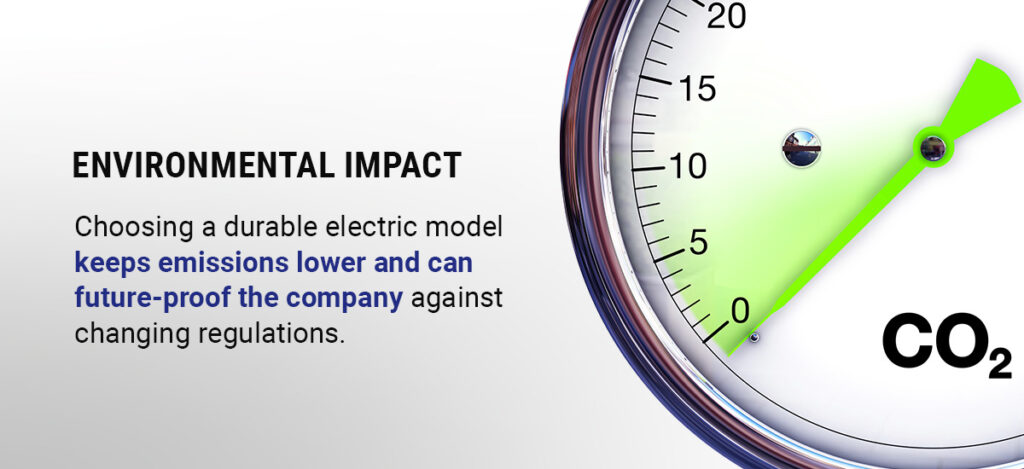
6. Dealer Support
Companies should consider the proximity, reputation and service level of the equipment dealership they plan to work with. A reliable equipment dealer provides representatives with extensive expertise in the machines they carry to help buyers find the exact model to meet their needs.
Dependable dealers help you ensure the right parts are available when you need them. Preventive maintenance helps reduce the risk of breakdowns and unexpected downtime. Your dealer should be able to procure OEM parts for your equipment to ensure the best and most efficient repair results.
Evaluate how the chosen dealer impacts procurement flexibility. Each dealer has different financing, leasing or trial options available to help make their equipment more accessible to customers.
7. Motive Power Type
The specific type of motive power a forklift uses directly impacts factors like power output, work efficiency and maintenance requirements. For ICE forklifts, these options include:
- Diesel: Diesel forklifts are powerful, with high torque generation and heavy lifting capacities. Because diesel fuel produces toxic fumes, forklifts with these engines should only be used in outdoor applications.
- LPG: Also known as propane, LPG is a widely available and cost-effective choice for forklift fuel. It burns more cleanly than diesel or gas, making it safer for indoor applications with proper ventilation.
- Natural gas: CNG forklifts are less common than LPG or diesel due to the fuel’s lack of availability and high costs. However, they do provide enough power for heavy-lifting applications in demanding environments.
- Gasoline: Gasoline is a convenient option for job sites located near refilling stations due to their short refueling time. However, companies must consider how they’ll vent carbon emissions when using this fuel type.
Similarly, electric forklift motors provide various motive power options in the types of batteries they use.
Electric and ICE forklifts can also be retrofitted to use hydrogen fuel cells, which provide continuous, clean operation and rapid refueling for maximum efficiency.
8. Durability and Build Quality
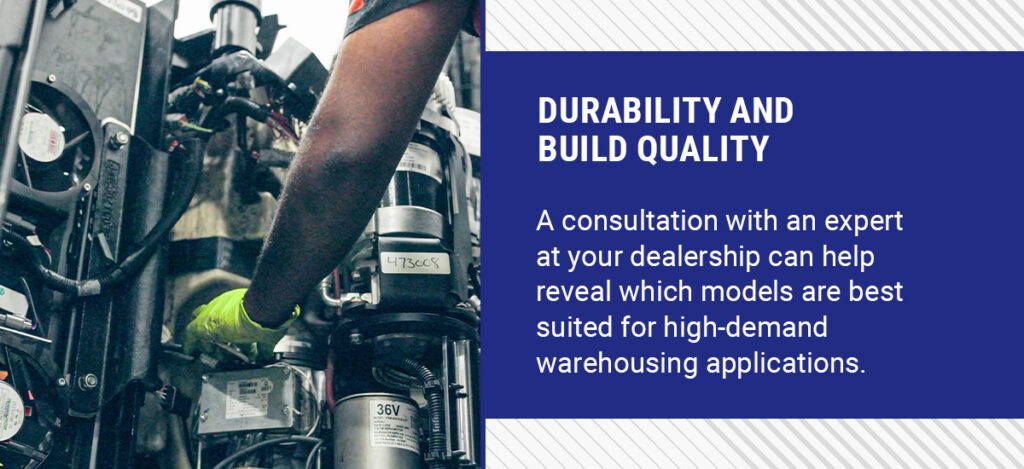
Buyers should choose equipment that can handle the demands of their typical operational environment. This consideration is critical for minimizing downtime, which impacts revenue.
A consultation with an expert at your dealership can help reveal which models are best suited for high-demand warehousing applications that require long life spans and reduced maintenance and repair costs.
9. Warehouse Layout
The layout of your warehouse and the design of your racking are crucial considerations because they impact your forklift specifications.
For example, a warehouse with narrow aisles and high shelving would likely benefit most from an electric reach truck with cushion tires. This forklift’s compact footprint and purpose-driven design enable the operator to easily maneuver loads in tight spaces.
Should You Purchase or Rent a Forklift?
Any fleet manager who wants to expand or upgrade their equipment should consider key factors to determine whether renting or purchasing is the better option:
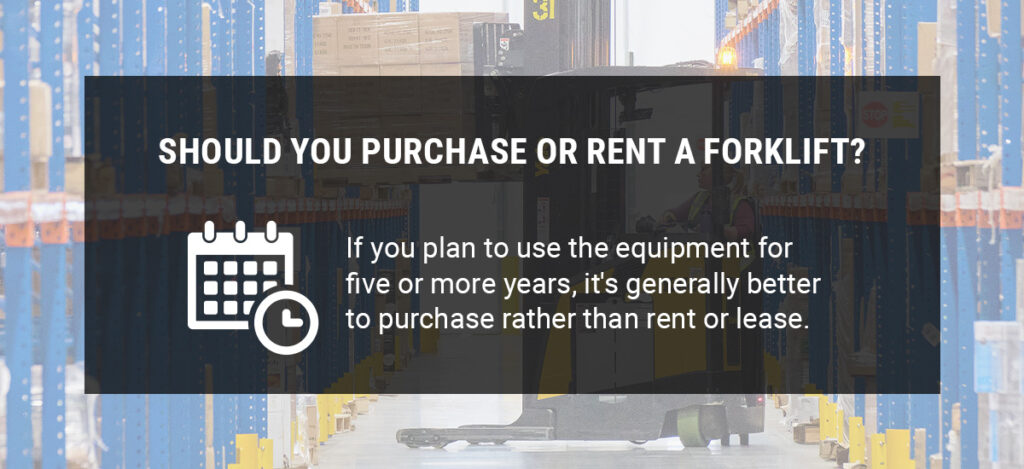
- Duration of use: If you plan to use the equipment for five or more years, it’s generally better to purchase rather than rent or lease. Short-term periods lasting a few weeks to a few months benefit most from equipment rentals due to the reduced maintenance and storage costs. A standard lease, which involves leasing usage of the forklift, is often best for medium-term periods lasting between one to five years. Beyond five years, a capital lease — sometimes called a finance lease — can be a good solution.
- Budget and cash flow: While leases and rentals provide opportunities to save on upfront costs, purchasing a forklift may provide better long-term value for businesses with the available capital.
- Utilization rate: A purchase benefits businesses with higher, more regular daily forklift usage. Businesses with low or irregular usage should consider renting over leasing or buying.
- Maintenance capabilities: Businesses that choose to purchase usually opt for preventive maintenance (PM) and repair services from their dealerships to ensure their fleet forklifts operate reliably. Some leases and most rental agreements shift these responsibilities to the equipment provider, which can be more convenient for smaller or busier businesses.
- Operational flexibility: Equipment ownership provides unrestricted flexibility, while rentals and leases may place limits on hours or modifications.
- Industry-specific factors: Seasonal industries and third-party logistics (3PL) companies benefit most from short-term arrangements like rentals, while high-demand industries lean toward purchases or long-term leases to handle continuous demand.
- Technology requirements: Rentals allow companies to test the latest models and operator technologies before they commit to a full purchase.
Consult with an equipment expert at your dealership to determine which arrangement works best for your company.
Black Equipment Can Help You Find the Ideal Forklift for Your Warehouse
While this guide provides valuable insight into choosing a warehouse forklift, there’s no substitute for working with a qualified and experienced expert who’s provided similar solutions to companies with complicated operational demands like yours.
For decades, the experts at Black Equipment have conducted thorough and detailed audits and surveys at customer facilities like yours to gain a more complete understanding of the following:
- Goals
- Workflows
- Travel patterns
- Shelving restrictions
- Lift and travel height needs
- Load and angle requirements
- Power needs
- Safety and comfort
- Technological requirements
They also know the unique capabilities of a wide range of Yale and Hyster forklift models, which are leaders in material handling.
Contact us online or visit your nearest location today to get started.
